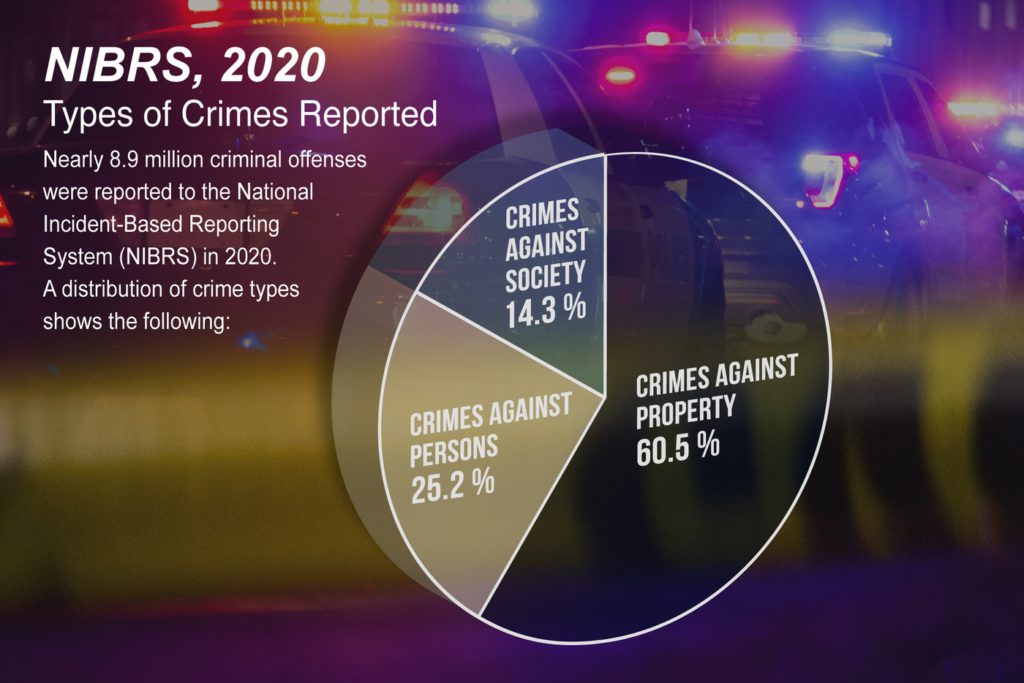
Crimes Against Property Remained Most Reported Major Criminal Offense Category In 2020: NIBRS Data
By a Biometrica staffer
On Monday, Dec. 6, the Federal Bureau of Investigation (FBI) published data on nearly 8.9 million criminal offenses reported via the National Incident-Based Reporting System (NIBRS) in 2020. Of the total 8,879,728 offenses reported in 7,560,867 incidents, 60.5% fell under the crimes against property criminal offense category; 25.2% were crimes against persons; and 14.3% were crimes against society.
NIBRS data cannot be compared on an apples to apples basis from one year to another. But, for general understanding, the distribution of criminal offenses by category were very similar even per 2019 statistics. In 2019, the FBI published data on nearly 7.7 million criminal offenses in 6,572,870 incidents. Of those, 59.6% were crimes against property; 24.6% were crimes against persons; and 15.8% were crimes against society.
When it comes to crimes against persons, assault offenses made up the largest category of both incidents and offenses, followed in descending order by sex offenses, kidnapping/abduction, homicide offenses and, finally, human trafficking. Under crimes against property, larceny/theft offenses made up the most reported sub-category among the top five sub-categories, followed by destruction/damage/vandalism of property, fraud offenses, burglary/breaking & entering, and motor vehicle theft.
Within the broader crimes against society category, drug/narcotic offenses accounted for an overwhelming majority, followed by weapon law violations, pornography/obscene material related offenses, animal cruelty, prostitution offenses, and gambling offenses.
Per the NIBRS report, some incidents were counted two or more times when there were two or more offense types within the incident. While referring to victims, the figures represent the number associated with each offense type. The term known offender does not imply that the identity of the suspect is known, but only that an attribute of the suspect has been identified which distinguishes him/her from an unknown offender.
In this piece, we delve further into the data contained in the FBI Uniform Crime Reporting (UCR) Program’s latest report, NIBRS, 2020.

Highlights Of The Report
We begin by looking at some of the key highlights of the NIBRS 2020 report.
Participation — In 2020, 9,880 law enforcement agencies, whose jurisdictions covered more than 177.5 million U.S. inhabitants, submitted NIBRS data to the UCR Program. These agencies accounted for 62.1% of the 15,901 law enforcement agencies that submitted data to the UCR Program in 2020. In 2019, 8,497 law enforcement agencies, whose jurisdictions covered more than 146.5 million U.S. inhabitants, submitted NIBRS data to the UCR Program. These agencies accounted for 51.3% of the 16,551 law enforcement agencies that submitted data to the UCR Program in 2019.
Victims — The 9,362,709 victims reported via NIBRS include individuals, businesses, institutions, or society as a whole. For 2020, the data regarding the 6,597,394 victims who were individuals showed:
- Of these victims, 23.8% were between 26 and 35 years old. In 2019, (based on data regarding the 5,547,758 victims who were individuals) 23.6% were between 21 and 30 years old.
- A little more than half (50.6%) were female; 48.7% were male; and the gender of 0.8% of victims was unknown, per the 2020 data. That’s very similar to the categorization in 2019.
- Most victims (66.9%) were white; 24% were Black; 1.9% were Asian; 0.8% were American Indian or Alaska Native; and 0.2% were Native Hawaiian or Other Pacific Islander per the latest report. The race of 6.2% of victims was unknown.
Per the 2019 data, 68% were white; 23.3% were Black; 1.9% were Asian; 0.7% were American Indian or Alaska Native; and 0.5% were Native Hawaiian or Other Pacific Islander. The race of 5.6% of victims was unknown. - Data captured about the relationship of victims to their offenders show that just over half (50.1%) of the victims knew their offenders (or at least one offender when more than one was present) but did not have a familial relationship to them. About one quarter (24.7%) of the victims were related to their offenders (or at least one offender when more than one was present). Of the remaining 25.2% of victims, the relationships to their offenders were categorized as strangers, mutual combatants (victim was offender), or unknown.
Known Offenders — In 2020, law enforcement reported information about 7,173,072 known offenders, meaning some aspect of the suspect — such as age, gender, or race — was known.
- Of these offenders, 38.2% were between 21 and 35 years of age. In 2019, 38.4% were between 16 and 30 years of age.
- By gender, most offenders (62.1%) were male; 24.2% were female; and the gender for 13.7% of known offenders was unknown. Per 2019 data too most offenders were male and around 25% were female, and a similar number were unknown.
- By race, more than half (50.8%) of known offenders were white; 29.6% were Black; and 2.2% were of other races. The race was unknown for 17.4% of reported known offenders. That’s similar to the numbers as per 2019’s data.
Arrestees — Law enforcement agencies submitted data to the UCR Program through incident reports and arrest reports for 3,621,299 arrestees.
- In 2020, of these arrestees, 31.9% were 26 to 35 years of age (similar to 2019).
- By gender, 72.6% were male; and 27.4% were female (that ratio is up a little for females from 2019).
- By race, most arrestees (67.7%) were white; 27.1% were Black; and 2.9% were of other races. The race was unknown for 2.2% of arrestees (once again, similar to 2019 trends).